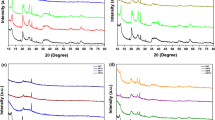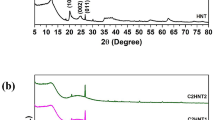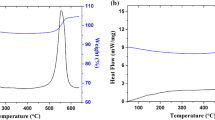Abstract
Pristine halloysite nanotubes (HNTs) were studied by thermogravimetry (TG) up to 800 °C. Etching of alumina from inside the tube (causing a significant increase in tube lumen) was realized by treating the material with an acidic H2SO4 solution at 50 °C. Both materials were characterized by TG-FTIR techniques and their thermal behaviors were compared with that of kaolinite. The coupling of TG with FTIR enables to detect the gases evolved during the TG experiments, thus confirming that only pristine HNTs undergo dehydration with the loss of interlayer water molecules at around 245 °C, while dehydroxylation occurs in all these materials in close temperature ranges around 500 °C. TG runs at five different heating rates (2, 5, 10, 15 and 20 °C min−1), was carried out in the same experimental conditions used for the thermal analysis study with the aim to investigate dehydration and dehydroxylation kinetics using some isoconversional methods recommended by the ICTAC kinetic committee, and thermogravimetric data under a modulated rising temperature program. Finally, the results of the kinetic analysis were discussed and explained in terms of the strengths of the hydrogen bonds broken during these processes.





Similar content being viewed by others
References
Du M, Guo B, Jia D. Newly emerging applications of halloysite nanotubes: a review. Polym Int. 2010;59:574–95.
Price R, Gaber B, Lvov Y. In vitro release characteristics of tetracycline, khellin and nicotinamide adenine dinucleotide from halloysite; a cylindrical mineral for delivery of biologically active agents. J Microencapsul. 2001;18:713–23.
Abdullayev E, Lvov Y. Clay nanotubes for corrosion inhibitor encapsulation: release control with end stoppers. J Mater Chem. 2010;20:6681–7.
Abdullayev E, Lvov Y. Clay nanotubes for controlled release of protective agents—a review. J Nanosci Nanotechnol. 2011;11:10007–26.
Liu M, Guo B, Du M, Cai X, Jia D. Properties of halloysite nanotube-epoxy resin hybrids and the interfacial reactions in the systems. Nanotechnology. 2007;18:455703/1–9.
Abdullayev E, Lvov Y. Halloysite clay nanotubes as a ceramic “skeleton” for functional biopolymer composites with sustained drug release. J Mater Chem B. 2013;1:2894–903.
Lvov Y, Price R, Gaber B. Thin film nanofabrication via layer-by-layer adsorption of tubule halloysite, spherical silica, proteins and polycations. Colloids Surf A. 2002;198–200:375–82.
Liu M, Guo B, Du M, Jia D. Drying induced aggregation of halloysite nanotubes in polyvinyl alcohol/halloysite nanotubes solution and its effects on properties of composite films. Appl Phys A. 2007;88:391–5.
Wei W, Abdullayev E, Hollister A, Mills D, Lvov Y. Clay nanotube/poly(methyl methacrylate) bone cement composite with sustained antibiotic release. Macromol Mater Eng. 2012;297:645–53.
Cavallaro G, Lazzara G, Milioto S. Dispersions of nanoclays of different shapes into aqueous and solid biopolymeric matrices. Extended physico-chemical study. Langmuir. 2011;27:1158–63.
Veerabadran N, Price R, Lvov Y. Clay nanotubes for encapsulation and sustained release of drugs. NANO. 2007;2:215–22.
Shchukin D, Price R, Lvov Y. Biomimetic synthesis of vaterite in the interior of clay nanotubules. Small. 2005;1:510–3.
Shamsi MH, Geckeler KE. The first biopolymer-wrapped non carbon nanotubes. Nanotechnology. 2008;19:1–5.
Joshi A, Abdullayev E, Vasiliev A, Volkova O, Lvov Y. Interfacial modification of clay nanotubes for the sustained release of corrosion inhibitors. Langmuir. 2013;29:7439–48.
Suh Y, Kil D, Chung K, Abdullayev E, Lvov Y, Mongayt D. Natural nanocontainer for the controlled delivery of glycerol as a moisturizing agent. J Nanosci Nanotechnol. 2011;11:661–5.
Abdullayev E, Joshi A, Wei W, Zhao Y, Lvov Y. Enlargement of halloysite clay nanotube lumen by selective etching of aluminium oxide. ACS Nano. 2012;6(8):72167226.
Singh B. Why does halloysite roll?—a new model. Clays Clay Miner. 1996;44:191–6.
Gasparini E, Tarantino SC, Ghigna P, Riccardi MP, Cedillo-González EI, Siligardi C, Zema M. Thermal dehydroxylation of kaolinite under isothermal conditions. Appl Clay Sci. 2013;80–81:417–25.
Vecchio Ciprioti S, Catauro M. Synthesis, structural and thermal behavior study of four Ca-containing silicate gel-glasses: activation energies of their dehydration and dehydroxylation processes. J Therm Anal Calorim. 2015. doi:10.1007/s10973-015-4729-3.
Cheng H, Yang J, Liu Q, Frost RL. Thermogravimetric analysis–mass spectrometry (TG–MS) of selected Chinese kaolinites. Thermochim Acta. 2010;507–508:106–14.
Ptácek P, Soukal F, Opravil T, Havlica J, Brandstetr J. The kinetic analysis of the thermal decomposition of kaolinite by DTG technique. Powder Technol. 2011;208:20–5.
Ptácek P, Soukal F, Opravil T, Nosková M, Havlica J. The non-isothermal kinetics analysis of the thermal decomposition of kaolinite by effluent gas analysis technique. Powder Technol. 2010;203:272–6.
Ptácek P, Kubatova D, Havlica J, Brandstetr J, Soukal F. Isothermal kinetic analysis of the thermal decomposition of kaolinite: the thermogravimetric study. Thermochim Acta. 2010;501:24–9.
L’vov BV, Ugolkov VL. Kinetics and mechanism of dehydration of kaolinite, muscovite and talc analyzed thermogravimetrically by the third-law method. J Therm Anal Calorim. 2005;82:15–22.
Sánchez FG, van Loon LR, Ginni T, Jakob A, Glaus MA, Diamond LW. Self-diffusion of water and its dependence on temperature and ionic strength in highly compacted montmorillonite, illite and kaolinite. Appl Geochem. 2008;23:3840–51.
Klevtsov DP, Logvinenko VA, Zolotovskii BP, Krivoruchko OP, Buyanov RA. Kinetics of kaolinite dehydration and its dependence on mechanochemical activation. J Therm Anal. 1988;33:531–5.
Adhikaria M, Majumdara MK, Pati AK. Thermal decomposition of vermiculites: kinetics of dehydration and dehydroxylation processes. Trans Indian Ceram Soc. 1983;42(5):124–7.
Murray P, White J. Kinetics of clay dehydration. Clay Miner. 1955;2:255–64.
Vyazovkin S, Burnham AK, Criado JM, Pérez-Maqueda LA, Popescu C, Sbirrazzuoli N. ICTAC Kinetic Committee recommendations for performing kinetic computations on thermal analysis data. Thermochim Acta. 2011;520:1–19.
Liu H, Chen T, Xie Q, Zou X, Qing C, Frost RL. Kinetic study of goethite dehydration and the effect of aluminium substitution on the dehydrate. Thermochim Acta. 2012;545:20–5.
Brown ME, Dollimore D, Galwey AK. Reactions in the solid state. Comprehensive chemical kinetics, vol. 22. Amsterdam: Elsevier; 1980.
Sestak J. Thermophysical properties of solids. Comprehensive analytical chemistry, vol. 12D. Amsterdam: Elsevier; 1984.
Blaine RL, Hahn BK. Obtaining kinetic parameters by modulated thermogravimetry. J Therm Anal. 1998;54:695–704.
Brown ME, Maciejewski M, Vyazovkin S, Nomen R, Sempere J, Burnham A, Opfermann J, Strey R, Anderson HL, Kemmler A, Keuleers R, Janssens J, Desseyn HO, Li CR, Tang TB, Roduit B, Malek J, Mitsuhashi T. Computational aspects of kinetic analysis Part A: the ICTAC kinetics project-data, methods and results. Thermochim Acta. 2000;355:125–43.
Flynn JH, Wall LA. A quick direct method for the determination of activation energy from thermogravimetric data. J Polym Sci B Polym Lett. 1966;4(5):323–8.
Ozawa T. A new method of analyzing thermogravimetric data. Bull Chem Soc Jpn. 1965;38:1881–6.
Doyle CD. Estimating isothermal life from thermogravimetric data. J Appl Polym Sci. 1962;6(24):639–42.
Akahira T, Sunose T. Paper No. 246, 1969 Research Report, Trans. Joint Convention of Four Electrical Institutes. Chiba Inst Technol (Sci. Technol.) 1971. vol. 16, p.22–31.
Starink MJ. The determination of activation energy from linear heating rate experiments: a comparison of the accuracy of isoconversion methods. Thermochim Acta. 2003;404:163–76.
Lesnikovich AI, Levchik SV. Isoparametric kinetic relations for chemical transformations in condensed substances (Analytical survey). II. Reactions involving the participation of solid substances. J Therm Anal. 1985;30:677–702.
Lesnikovich AI, Levchik SV. A method of finding invariant values of kinetic parameters. J Therm Anal. 1983;27:89–93.
Pérez-Maqueda LA, Criado JM, Sánchez-Jiménez PE, Perejón A. Kinetic studies in solid state reactions by sample-controlled methods and advanced analysis procedures. J Therm Anal Calorim. 2013;113:1447–53.
Pérez-Maqueda LA, Criado JM, Gotor FJ, Málek J. Advantages of combined kinetic analysis of experimental data obtained under any heating profile. J Phys Chem A. 2002;106:2862–8.
Vyazovkin S, Wight CA. Kinetics in solids. Annu Rev Phys Chem. 1997;48:125–49.
Simon P. Isoconversional methods. Fundamentals, meaning and application. J Therm Anal Calorim. 2004;74:123–32.
Vyazovkin S. Evaluation of the activation energy of thermally stimulated solid-state reactions under an arbitrary variation of the temperature. J Comput Chem. 1997;18:393–402.
Vyazovkin S. Modification of the integral isoconversional method to account for variation in the activation energy. J Comput Chem. 2001;22:178–83.
Vyazovkin S, Dollimore D. Linear and non linear procedures in isoconversional computations of the activation energy of thermally induced reactions in solids. J Chem Inf Comput Sci. 1996;36:42–5.
Budrugeac P, Segal E. Thermal analysis in the evaluation of thermal lifetime of solid polymeric materials. Thermochim Acta. 1992;211:131–6.
Coats AW, Redfern JP. Kinetic parameters for thermogravimetric data. Nature. 1964;201:68–9.
Garcia FJ, Rodríguez SG, Kalytta A, Reller A. Study of natural halloysite from the Dragon Mine, Utah (USA). Z Anorg Allg Chem. 2009;635(4–5):790–5.
Badogiannis E, Kakali G, Tsivilis S. Metakaolin as supplementary cementitious material. Optimization of kaolin to metakaolin conversion. J Therm Anal Calorim. 2005;81:457–62.
NIST Chemistry WebBook Standard Reference Database, http://webbook.nist.gov/chemistry.
da Silveira Petruci JF, Fortes PR, Kokoric V, Wilk A, Raimundo IM Jr, Cardoso AA, Mizaikoff B. Monitoring of hydrogen sulfide via substrate-integrated hollow waveguide mid-infrared sensors in real-time. Analyst. 2014;139:198–203.
Heide K, Foldvari M. High temperature mass spectrometric gas-release studies of kaolinite Al2[Si2O5(OH)4] decomposition. Thermochim Acta. 2006;446:106–12.
Prado JR, Vyazovkin S. Activation energies of water vaporization from the bulk and from laponite, montmorillonite, and chitosan powders. Thermochim Acta. 2011;524:197–201.
Acknowledgements
The authors acknowledge the financial support from FIRB 2012, Clay nanotubes for designing eco-compatible smart materials, funded by the Italian Ministry of University and Research (Project No. RBFR12ETL5) and Dr. Giuseppe Lazzara and Prof. Peter Simon for helpful discussions.
Author information
Authors and Affiliations
Corresponding author
Rights and permissions
About this article
Cite this article
Duce, C., Vecchio Ciprioti, S., Ghezzi, L. et al. Thermal behavior study of pristine and modified halloysite nanotubes. J Therm Anal Calorim 121, 1011–1019 (2015). https://doi.org/10.1007/s10973-015-4741-7
Received:
Accepted:
Published:
Issue Date:
DOI: https://doi.org/10.1007/s10973-015-4741-7




